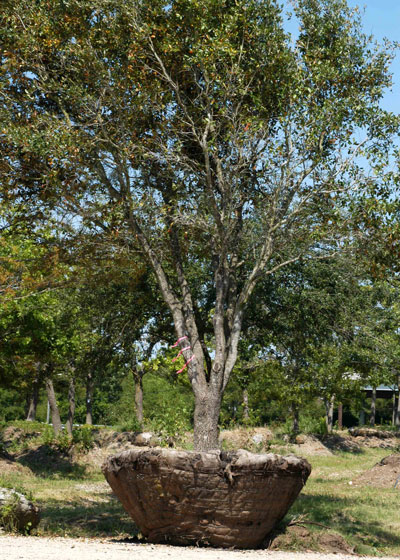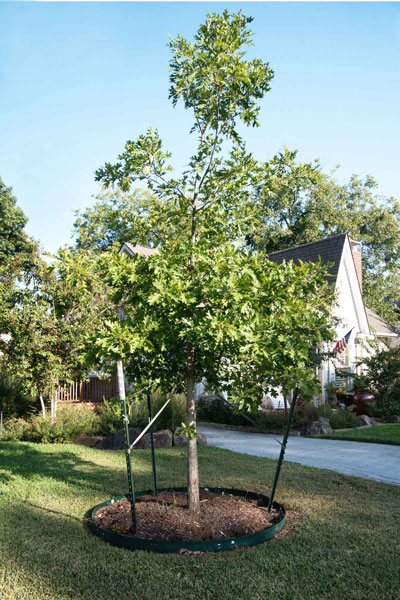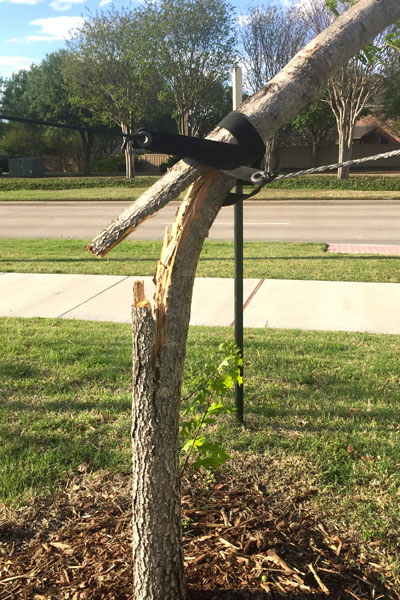Staking A New Tree
The question I hear many times every year is, “Neil, my tree isn’t straight. Will it eventually grow straight, or can I pull it up into a vertical position?”
That’s when I have to share the bad news with them. Trees don’t look in their mirrors. They don’t have moms to tell them to improve their postures. Trees simply don’t care how they look. They just want to grow, and if that means growing at a 10-degree slant, they’re OK with that.
And no, they won’t self-correct. And while I’m piling on the things you didn’t want to hear, you can’t pull a tree back into vertical. As soon as you release the cables or stakes, it’s going to lean right back where it was. Even years later.
So if you have a tree with a lean, your only options are (1) dig and reset it so that it’s upright, or (2) learn to enjoy it with that lean.

Photo: This tree will obviously be delivered and planted by the nursery that is selling it. The final step in that planting will be to stake and secure it.
But to avoid that problem in the future…
It makes a lot more sense, when we buy a lovely new tree, to stake it and secure it until it’s firmly rooted, so that it will be upright forever.
We’ve talked about how you dig a hole to plant a new tree exactly the depth of that tree’s soil ball. That way it’s resting on firm soil that won’t settle.
And you fill in with the same soil you just dug out of the hole. You use the extra soil to create a berm around the plant just outside the edge of the planting hole. That berm becomes your reservoir, and that’s where you water your new tree every three or four days. You use a garden hose, and you fill the berm slowly so that water gets to the bottom of the root ball.

Photo: This young Shumard red oak was planted carefully and secured perfectly. I’ll use it to illustrate my steps in staking a new tree.
And now for the staking…
As I mentioned, this is my own personal preference. It’s easy, and it’s secure. It doesn’t involve driving nails into a tree’s trunk.
• Drive in three stakes 120 degrees (one-third of a circle) apart. One stake should be due south of the trunk, because that’s where the prevailing winds are during the summer while the tree is leafed out like a big sailboat. One stake would then be northeast and one northwest of the trunk.
• Use cable and cable clamps as your means of securing the trunk. Run the cables through short sections of old garden hose to keep them from rubbing through the tree’s bark.

Be sure your support cables are high enough on the trunk. This tree in West McKinney snapped in the wind yesterday morning. The strong winds caught the leaf canopy and popped the trunk.
• Install the cables 40 to 60 percent of the way up the trunk. I see many people cabling their trees way too low. That type of cabling will not offer much support if a strong wind blows through.
• Keep the cables completely taut at all times. Some people use rope. You look at their trees a few weeks after they’re planted, and the rope is sagging like a jump rope. That could cause a big problem in a sudden windstorm. Think of a dog on a chain – one that decides to run after a delivery person. When he comes to the end of the chain, there’s an abrupt jerk. That same thing can happen with a slack rope, and a young tree’s trunk could snap with the burst of wind.
• Leave the tree staked for at least one year (smaller trees), or two or three years for larger trees. Check the cable and sections of hose to be sure they’re not causing damage to the trunk. If they are, adjust them to another spot on the trunk.
• The one thing missing in my photo of this well-secured Shumard red oak in McKinney is tree wrap. Technically it’s not a part of the staking and guying we do for a new tree, but it’s a critical part of planting new trees with thin bark. That list includes Shumard red oak, chinquapin oak, water oak and Chinese pistachio. Each of these trees needs to be protected from sunscald and subsequent borer invasion by a paper tree wrap. Good hardware stores and nurseries offer it. It expands as the trunk grows, so leave it in place for one to two years.
